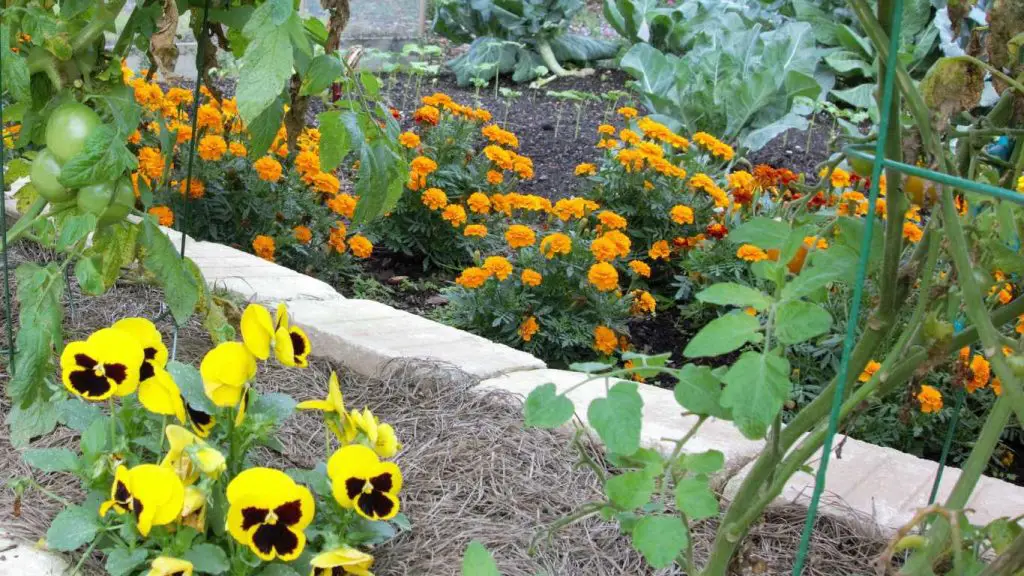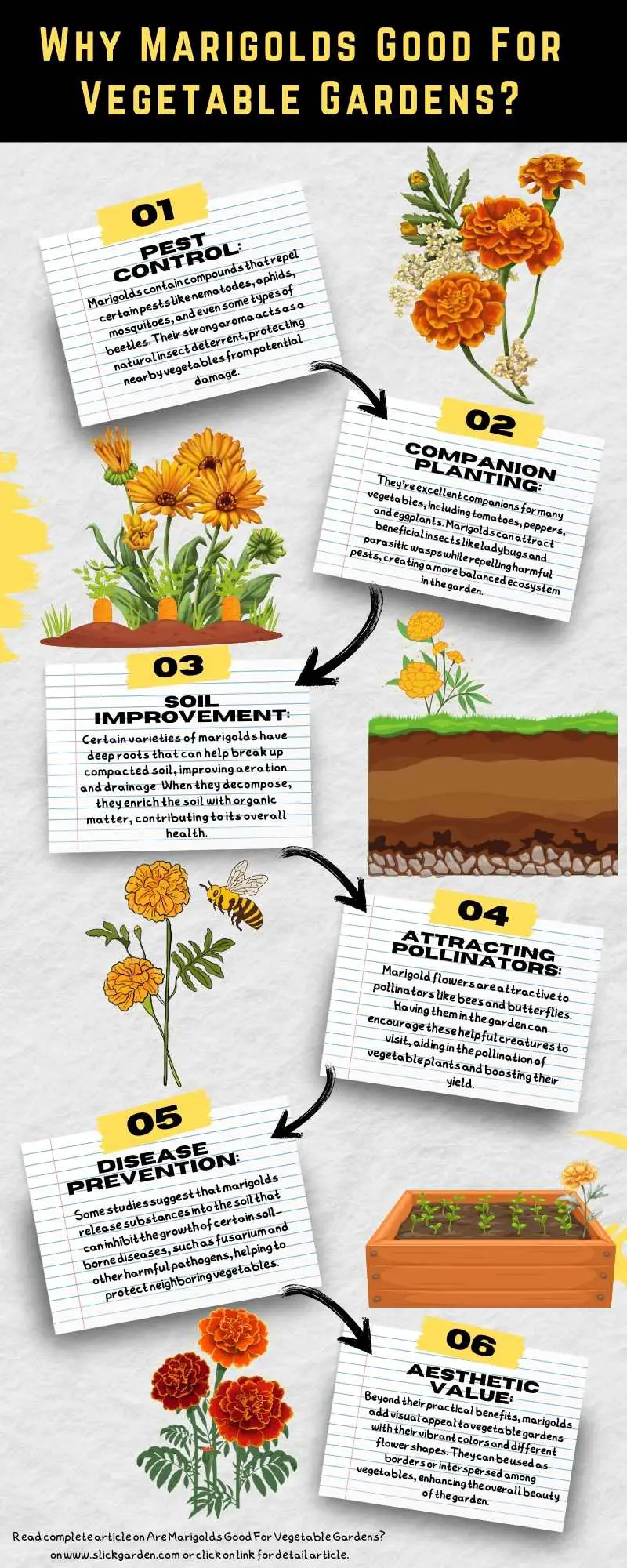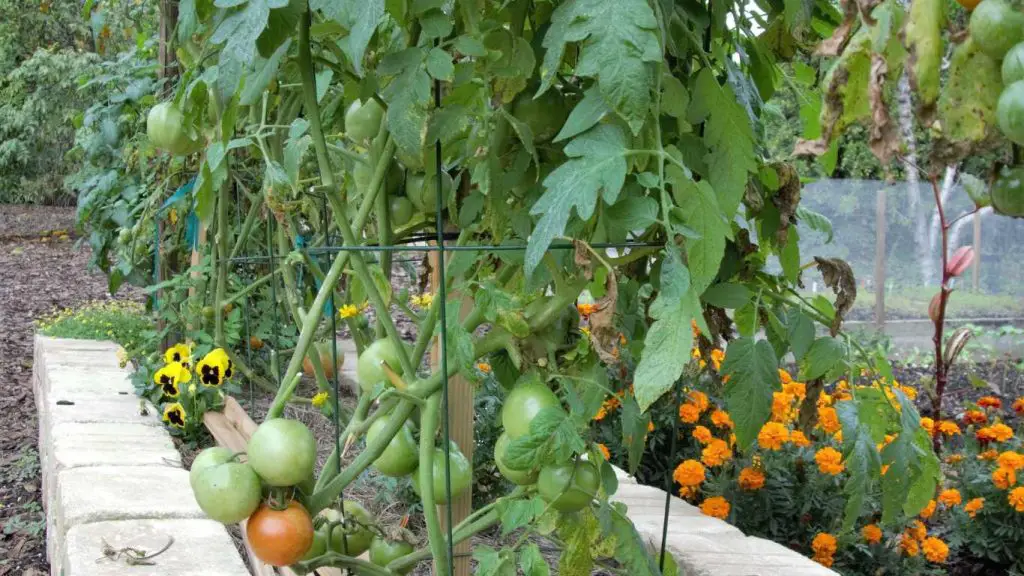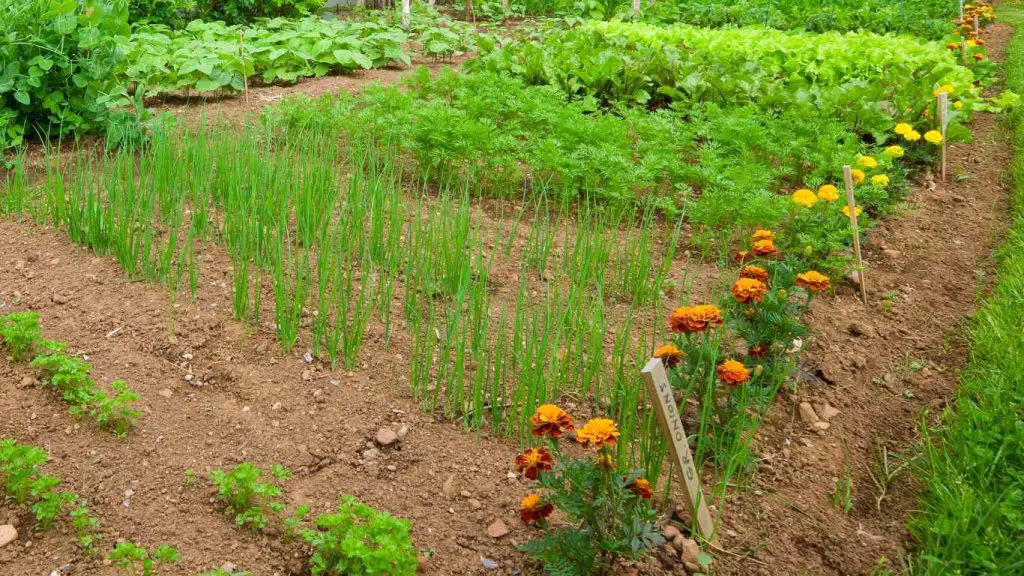As you know flowers add colors to your garden and their presence makes your mood refreshed. It is believed that flowers should not be grown in a vegetable garden.
But this practice is beneficial for growing your vegetable garden organically. There are many reasons for growing ornamental flowers in your vegetable garden.
They help protect the soil’s structure, improve the diversity of plants, and make your garden more attractive.

When it comes to growing flowers in the vegetable garden, Marigold is number one on the list. Marigolds are pretty bright blooms that deserve a spot in your garden.
Marigolds are included in those flowering plants that need little maintenance. They are less fussy so they can be the best companion for other plants.
They must be added for ornamental landscaping. You can easily grow them in pots, containers, raised beds, and hanging baskets. These attractive flowers are available in different colours and they like to thrive in full sun exposure.
Why Are Marigolds Good?
Following are the reasons for growing very well in your garden. This article will be helpful for you in deciding whether you should grow marigolds in your vegetable garden or not.
1- MARIGOLD ARE SUPER HARDY
The flowering plants need your attention and time. They need frequent watering to grow healthier but if we talk about marigolds they can easily tolerate drought.
They can easily handle temperature fluctuation and even bloom in the fall. They can easily adjust to a wide range of soil types but they love full sun exposure. You must choose a sunny area in your vegetable garden for growing them.
The ideal time for growing Marigold is 4 to 6 weeks before the last frost date. If you don’t know about the last frost date in your area then you can ask your local nursery.
They will guide you about the date of the frost. The seeds of marigolds soon germinate within 1 to 2 weeks after sowing.
If you don’t want to grow marigolds from seeds although it is an inexpensive way of growing plants. You can also buy young plants from the local nursery or gardening Store.
2- MARIGOLDS ATTRACT POLLINATORS
Another reason for choosing marigolds as a flowering plant for your vegetable garden is they attract pollinators such as butterflies and bees.
As you know pollinators play an important role in a perfect ecosystem because pollinators visit different flowering plants and help in the pollination process of different vegetable plants such as tomatoes and squash.
The presence of flowering plants encourages different pollinators. It means marigolds perform the best function of companion flowering plants for your vegetable garden. You can grow different types of flowering plants in a vegetable garden to attract pollinators.
3- MARIGOLDS DETER PESTS
Pests are a big problem for your vegetable garden. These tiny monsters make the life of your plants difficult. They spread different fungal diseases and destroy your plants. Marigolds help to deter different pests such as cabbage worms.
Different insects such as lacewings, ladybugs, hoverflies, and wasps are attracted by marigolds. These insects eat aphids and other pests. They help in organic pest control in your vegetable garden. These beneficial insects make a balance in an ecosystem.
4- MARIGOLD ARE EDIBLE PLANTS
Some cultivars of marigolds are edible so you can easily grow them in your vegetable garden. The best edible Marigold varieties are French Marigold, African Marigold, Pot Marigold, Mexican Mint Marigold, and Lemon Marigold.
The flavor of Mexican Mint Marigold is tarragon and Lemon Marigold has a citrusy flavor. The petals of the Pot Marigold have a bright orange color with a mild flavor.
When you buy the seeds of Marigold they contain all the information about the plant whether it is edible or not. If you are buying young Marigold plants from a local nursery or gardening store then you can ask them whether you can eat them or not.
If you buy Marigolds from a florist then they will not be edible. They not only perform the function of best companion plants but also edible crops. The petals of marigolds are used in salads to enhance their flavor.
5- MARIGOLD AS CUT FLOWER
The floral display looks amazing when you use Marigold as a cut flower. Marigolds bloom from late spring to fall. Different colors of this flowering plant create a bright display in your floral arrangement.
Marigold flowers have delicate structures and thin petals so you must keep them in a dry and cool place. Make sure your flower arrangement must be away from direct sunlight otherwise, they will wilt within a day or two.
If you want to prevent your Cut flowers from bacteria then you must change water every 2 to 3 days. It will also extend the life of the flowers.
6- MARIGOLD CAN BE USED TO MAKE NATURAL YELLOW FOOD COLOURING
You can use marigolds as a natural yellow food color. Most of the people considered it as a poor saffron alternative. The color of the soups and stew is enhanced when you use them.
When the chickens eat the petals of marigold they will lay eggs that have a natural golden colour of yolks.
7- USE MARIGOLD AS A NATURAL FABRIC DYE
Mexican Marigolds have orange and yellow flowers and their petals can be used as a natural dye. The rich yellow color is easy to extract.
You can use marigold flowers for dying cotton and silk. When you use dyes from marigold then it will avoid environmental pollution.
8- MARIGOLD PRODUCE CHEMICAL AGAINST HARMFUL NEMATODES
Nematodes are thread-like creatures. They are very small and create many problems for plants. Thousands of nematodes exist in your vegetable garden.
It is not easy to deal with them so it is better to grow Marigolds as a companion plant for your vegetable plant as they kill nematodes in their growing spot.
Marigolds excrete a chemical in their roots that can help to reduce the population of nematodes. It means the addition of Marigolds will not be harmful to your vegetable garden but it will help you in warding off harmful nematodes.
9- AS AN EFFECTIVE TRAP CROP
A trap crop helps to keep harmful pests away from your favorite vegetable plants. For instance, if you are facing the problem of slugs you can grow marigolds around the edges of vegetable plants as slugs love marigolds so you can protect your vegetable crops that are more valuable for you. When you see slugs are drawn to the marigolds then you can collect them and fight with this problem.
10- MEDICINAL PROPERTIES
These pretty flowers have many health benefits. They have been used in different remedies for centuries. Marigold flowers are used as an antiseptic.
Different skin diseases are treated with these effective petals. You can easily deal with rashes, eczema, minor wounds, premature aging, and wrinkles with the help of the nutrients of the flowers of marigolds.

Keep Reading:
- Best Flowers To Grow For Bouquets
- 20 Shade-Loving Flowering Plants
- What Flowers To Plant In The Fall And Winter?
Best Neighbouring Vegetable Plants With Marigold
In companion planting, plants help each other in their growth. Marigolds attract different pollinators such as ladybugs, bees, and butterflies that help in the pollination process.
They also deter different pests and a chemical that is excreted from their roots can cause nematodes. So they can perform the best function of companion plants.

You can’t grow every vegetable plant besides marigolds. The best vegetables that perform well in the presence of Marigold are
- Squash
- Eggplants
- Lettuce
- Asparagus
- Melons
- Potatoes
- Beans
- Tomatoes
- Cabbage
- Cauliflower
- Broccoli
- Kale
Factors You Must Consider When Growing Marigold In A Vegetable Garden
There are different varieties of marigolds found in the world. Most of them are fit for growing in a vegetable garden. The colors of blooms produced range from cream to bride yellow and red. Before planting a marigold you must consider the following factors.
LOCATION
You can also grow these wonderful flowering plants in a container or hanging basket in your vegetable Garden. If you are growing marigolds in the ground then location is very important.
You can also create a wonderful border of marigolds around the edges of your garden beds. You must grow this wonderful companion plant near the vegetable plants that are the perfect neighbors for them.
SUNLIGHT
Full sun exposure is very important for the healthier growth of marigold plants. You must choose a sunny spot in your vegetable garden where they get at least 6 to 8 hours of sunlight daily.
If you grow marigold plants in our shady area then they become victims of powdery mildew and never produce blooms. For ideal growth, sunny locations are best so you must consider this factor before going to very cold plants in your vegetable garden.
SOIL
Marigold easily adjusts in all types of soil which is why you can easily grow them. If you are a beginner then you can select marigold as a flowering plant because you will not face any difficulty. Ideas soil is perfect for the plants to make them stress-free.
You can add compost to make the soil more richer and fertile. Before planting you must remove stones so the roots can easily spread in the soil.
Keep Reading:
- Vegetables That Grow Well In Clay Soil
- Vegetables That Can Grow In Sandy Soil
- 8 Fast Growing Vegetables That You Can Grow In A Hurry
Tips For Growing Marigold In A Vegetable Garden

As it is mentioned above growing a marigold in a vegetable golden is a simple task. Following are some tips if you follow them you will get the ideal growth of a marigold.
DEADHEAD OFTEN
There is no need for a deadheading for marigold flowers, but it will thrive well if you do it. For deadheading, you should gently pull the dead blooms with the help of two fingers. This will encourage the new growth of blooms.
DON’T OVERWATER
Before watering marigold plants, it is better to check the soil’s surface with your finger’s help. If it feels dry then it is the right time to water.
Over-watering is not good for marigold plants as it will encourage many fungal diseases. Rather than watering the leaves you must water at the base of marigold plants.
DON’T FERTILIZE DURING GROWTH
Another important suggestion is that you must not fertilize Marigold plants during the growing season. The ideal time of fertilizing is at the time of sowing the seeds or transplanting the seedlings.
If you apply fertilizer during the growing season then it will encourage the growth of foliage rather than the flowers as a result you will get only a few blooms.
SPREAD OUT MULCH
Another useful tip is the application of mulch around the Marigold plants as you know it will help to maintain the moisture level of the soil. it will also discourage the growth of weeds which are a big problem for your plans.
Weeds steal all the nutrients from the soil and there is a competition between weeds and plants for nutrients. Mulching helps slow the evaporation process so the soil retains the moisture.
